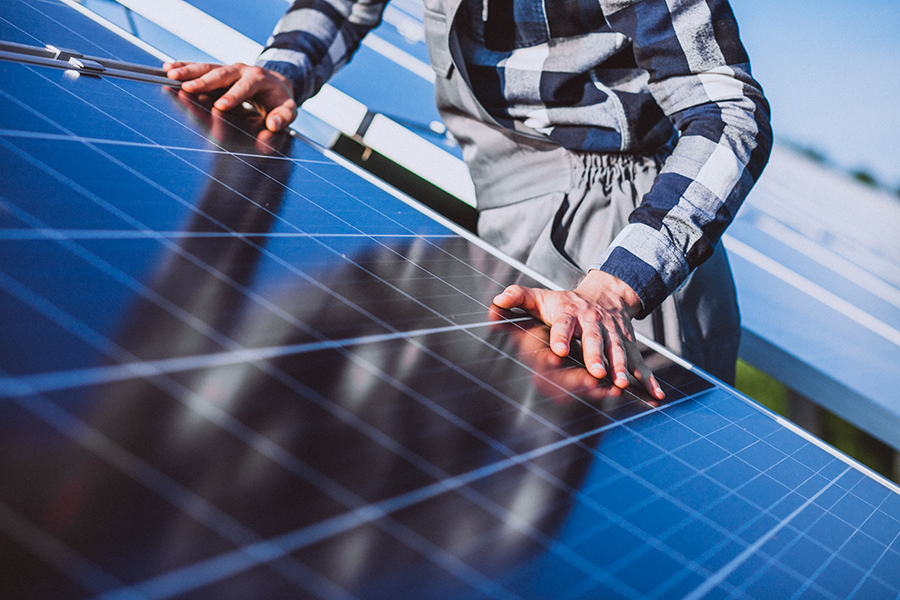A flagship piece of U.S. legislation – which backers tout as the biggest investment in clean energy and climate action in the country’s history – hit its one-year anniversary this week.
The hundreds of billions of dollars in climate funding authorized by the law, known as the Inflation Reduction Act (IRA), includes money for initiatives from weather-proofing homes to tax credits for solar and wind power projects and electric vehicles.
In an update to mark the anniversary, the White House called the IRA “a transformative law that is helping the United States meet its climate goals and strengthen energy security“.
Independent analyses project that the IRA will enable the U.S. to cut its planet-heating emissions substantially – though more needs to be done to hit U.S. President Joe Biden’s goal of halving emissions from 2005 levels by 2030.
Here’s how the IRA supports efforts to fight global warming and green the U.S economy – and where things may be headed next:
What are the major climate-related pieces of the law?
The IRA had initially authorized roughly $400 billion for programs and measures aimed at reducing greenhouse gas emissions, building climate resilience and creating green jobs – though recent estimates have projected those costs will swell.
The law’s provisions include expanded tax credits for renewable energy projects like wind and solar, a $27-billion revolving fund for clean energy, and $5 billion to help the U.S. Forest Service fight and prevent wildfires.
“It’s the most significant climate and clean energy legislation in U.S. history,” said Lori Bird, a renewable energy expert at the World Resources Institute (WRI), a research group.
National Climate Advisor Ali Zaidi highlighted the more than 100 projects to expand clean energy manufacturing announced since Biden signed the IRA into law in August 2022.
Zaidi pointed out that many of those projects are in places where jobs have disappeared, sometimes as a result of the transition away from fossil fuels – for example, an Indiana battery storage facility on the site of a retired coal plant.
“This is a reinvigoration of places that, frankly, (had) been left out of economic prosperity over the last several decades. This is bringing it back,” Zaidi told a briefing hosted by WRI.
The White House estimated that since the IRA became law, the private sector has announced new clean energy manufacturing investments of more than $110 billion.
It also pointed to outside assessments that the law’s clean energy and climate provisions have created more than 170,000 jobs – and could add a further 1.5 million jobs over the next decade.
Where does the law leave the U.S. on its emissions targets?
In 2021, Biden set a goal for the U.S. to cut its greenhouse gas emissions 50-52% below 2005 levels by 2030 on a path to hit “net zero” emissions economy-wide by 2050.
The IRA is projected to help the U.S. reduce its emissions by about 40% by 2030, multiple analyses show – meaning more action will be needed to hit the larger targets.
U.S. emissions are now projected to drop 29-42% by 2030, according to analysis from the Rhodium Group, a think tank.
“(The IRA is) an excellent start on the path forward to a clean energy transition, but it’s not enough to do everything we need to address climate change,” said WRI’s Bird.
Where does the IRA fall short of what activists are calling for?
Environmental groups have generally praised the bill and its benefits – but some have criticized language that, for example, makes approval of new renewable energy projects conditional on offering a certain acreage of new oil and gas leases.
Such provisions were critical in winning support for the IRA from lawmakers like Sen. Joe Manchin of West Virginia, a Democrat whose state is heavily reliant on fossil fuels. No congressional Republicans voted for the bill.
Jean Su, energy justice director at the nonprofit Center for Biological Diversity, said the IRA alone would not be sufficient to deliver the urgent action needed to tackle warming.
“President Biden needs to run, not walk, away from the climate catastrophe of fossil fuels,” Su said in a statement.
Advocacy groups are planning a huge demonstration in New York City in mid-September to deliver that same message and to push for more action as key U.N. climate meetings get underway.
Could the U.S. Congress revisit – and potentially repeal – parts of the IRA?
With Biden’s 2024 re-election prospects looking uncertain, congressional Republicans and other conservatives have already been talking about repealing what has thus far been the president’s signature domestic policy achievement.
Some experts argue that would be short-sighted.
“I think it’ll be difficult to undo the legislation – and I think the reality is that it’s going to benefit many of these red state regions,” said WRI’s Bird.
Still, Democrats have acknowledged they need to sharpen their sales pitch, particularly as Biden prepares to hit the campaign trail and the Republican presidential primary contest heats up.
Public polling since the IRA passed has shown that Americans support key provisionswhen described to them – but without that, many were not well-informed about the law.
“Our hope is that by seeing the transformation, by seeing the economic upside this becomes … increasingly irresistible politically,” said government advisor Zaidi.
Reporting by David Sherfinski; Editing by Megan Rowling






